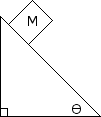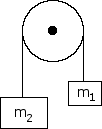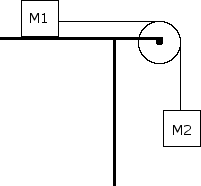Physics 1: Free Body Diagrams
An Object with mass m and initial velocity v is brought to rest by a constant force F acting for a time t and through a distance d. Possible expressions for the magnitude of the force F are: i. ii. iii.
ii only
iii only
i and ii only
ii and iii only
i, ii, and iii
Determine the acceleration and the value of the normal force. Draw a free body diagram.

M = 10kg, = 30 degrees
A block of mass M = 5kg is placed on an incline of = 30 degrees. There is a frictional force of 15 N opposing the movement of the block. Determine the acceleration of the block. Draw a free body diagram to help find the answer.

Determine the acceleration of the system if m = 5 kg and m = 10 kg and the pulley has no mass. Determine the tension in the rope as well.

A M = 6 kg box rests on a table and is connected to a second box of mass M = 5 kg via a rope that hangs over a frictionless pulley as shown. The coefficient of friction, is 0.15, Use free body diagrams to answer the following:

B. What is the tension in the rope?
A M = 8 kg box rests on a table and is connected to a second box of mass M = 4 kg via a rope that hangs over a pulley as shown. The coefficient of static friction, is 0.2, and the coefficient of kinetic friction is 0.1. Use a free body diagrams to answer the following.

B. If the box does cause the system to move, what is the acceleration of the system, and the tension in the rope?
The large block m is 6 kg, and the smaller block m is 12 kg. The coefficient of kinetic friction is 0.2. Determine the acceleration of the system and the Tension T . The applied force, F is 36 N. Also draw a free body diagram for both blocks.

A ball of mass M is thrown vertically upward with an initial speed of v0. It experiences a force of air resistance given by F=−kv, where k is a positive constant. The positive direction for all vector quantities is upward. Express all algebraic answers in terms of M, k, v0, and fundamental constants.
Does the magnitude of the acceleration of the ball increase, decrease, or remain the same as the ball moves upward?
Write, but do NOT solve, a differential equation for the instantaneous speed vof the ball in terms of time tas the ball moves upward.
Determine the terminal speed of the ball as it moves downward.
Does it take longer for the ball to rise to its maximum height or to fall from its maximal height back to the height from which it was thrown? Justify your answer.
Sketch a graph of velocity versus time for the upward and downward parts of the ball’s flight, where is the time at which the ball returns to the height from which it was thrown.
A small block of mass MB= 0.50 kg is placed on a long slab of mass MS= 3.0 kg as shown below. Initially, the slab is at rest and the block has a speed v0of 4.0 m/s to the right. The coefficient of kinetic friction between the block and slab is 0.20, and there is no friction between the slab and the horizontal surface on which it moves.

A 5 kg lawn mower is being pushed with an applied force of Fa= 20 N, at an angle of θ. There is a frictional force, F opposing the movement of the lawn mower of 10 N. Given that the lawn mower is accelerating at 0.4 m/s:

A block of mass mis pulled along a rough horizontal surface by a constant applied force of magnitude F1that acts at an angle θto the horizontal, as indicated below. The acceleration of the block is a1. Express all algebraic answers in terms of m, F1, θ, a1, and fundamental constants.

A rubber ball of mass m is dropped from a cliff. As the ball falls, it is subject to air drag (a resistive force caused by the air). The drag force on the ball has a magnitude bv2, where bis a constant drag coefficient and v is the instantaneous speed of the ball. The drag coefficient bis directly proportional to the cross-sectional area of the ball and the density of the air and does not depend on the mass of the ball. As the ball falls, its speed approaches a constant value called the terminal speed.
Draw and label all the forces on the ball at some instant before it reaches terminal speed.
State whether the magnitude of the acceleration of the ball of mass m increases, decreases, or remains the same as the ball approaches terminal speed. Explain.
Write, but do NOT solve, a differential equation for the instantaneous speed vof the ball in terms of time t, the given quantities, and fundamental constants.
Determine the terminal speed vtin terms of the given quantities and fundamental constants.
Determine the energy dissipated by the drag force during the fall if the ball is released at height hand reaches its terminal speed before hitting the ground, in terms of the given quantities and fundamental constants. (this question requires knowledge of potential and kinetic energy, often not introduced until later in a physics course)